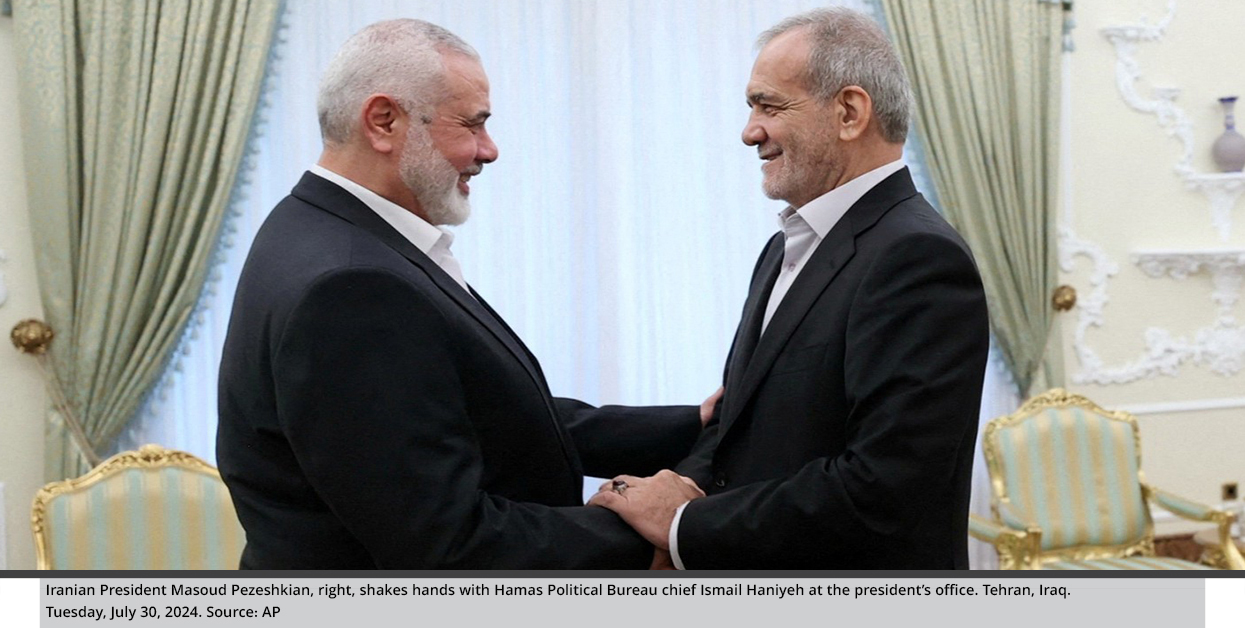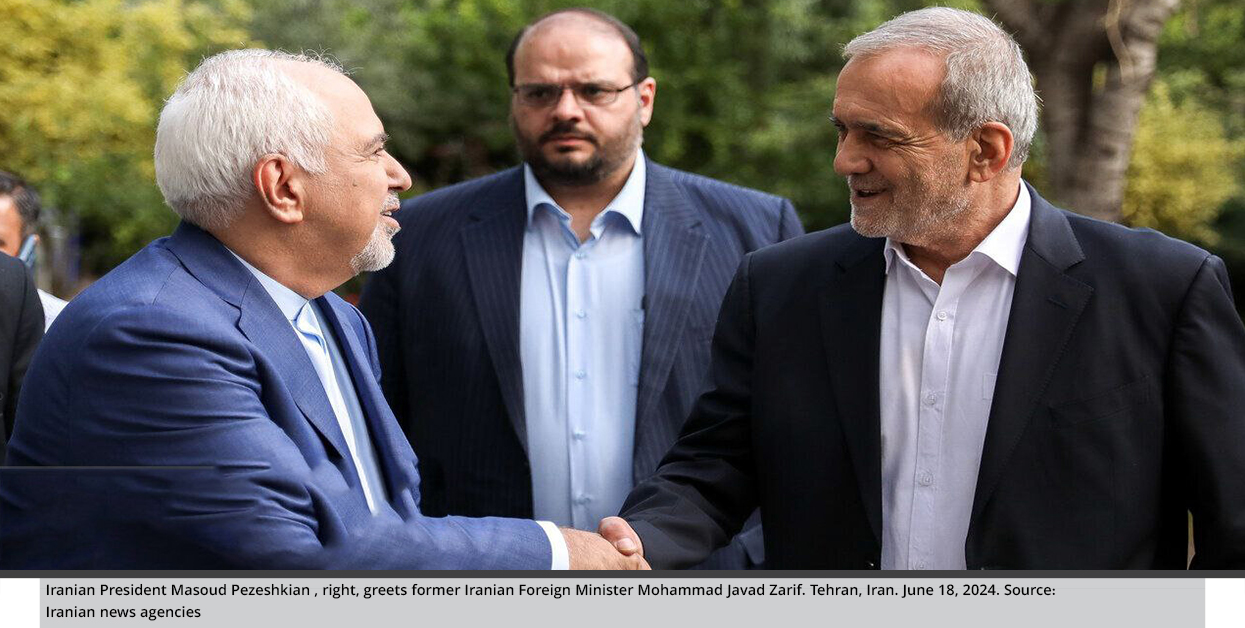Will the Presidency of Masoud Pezeshkian Change Iran’s Domestic and Foreign Policies?
The Iranian president’s ability to implement new programs is limited considering the failed efforts of the three previous reformist presidents. None of them managed to bring about significant changes in Iran’s domestic and foreign policies. Moreover, it is likely that Pezeshkian agenda will face strong opposition from the conservatives who dominate the parliament and the Assembly of Experts after their victory in the March 2024 elections.
by STRATEGIECS Team
- Release Date – Aug 28, 2024

President Masoud Pezeshkian assumed office July 6, 2024, amid a complex Iranian landscape of internal and external challenges. These include the gap between his reformist agenda and the dominance of hardliners regarding key institutions, a worsening economic crisis, and the circumstances of his succession following the death of former President Ebrahim Raisi in a plane crash on May 20, 2024. Additionally, there are geopolitical tensions accompanying the war in the Gaza Strip and Iran’s role in leading secondary fronts involved in the escalation against Israel. These factors raise questions about the reform president’s program, direction, and future policies.
The Difficult Win and the Challenges Ahead
The initial challenges relate to the circumstances of the president’s candidacy and difficult though expected victory after the first round of the elections ended without any candidate securing an absolute majority of votes: Pezeshkian won approximately 10 million votes; his rival, hard-line conservative Saeed Jalili, received about 9.4 million. The former cardiac surgeon’s victory in the second round ended the temporary intellectual and ideological harmony that characterized the relationship between state institutions during Raisi’s tenure, which marked the first relatively stable relationship between a president and Supreme Leader Ali Khameini. All of this surrounds Pezeshkian presidency with a range of internal and external challenges.
First, his Azerbaijani Turkish origin singled Pezeshkian out as the only one of the six presidential candidates without Persian origins. Despite his rivals campaigns based on ethnic reasons, the votes from non-Persian provinces were largely decisive in securing Pezeshkian victory in the second round of elections.
Second, the difficult internal economic conditions: an ever-rising $118 billion national debt, a national currency that has lost more than 30% of its market value, an inflation rate that remained above 40% until the end of 2023, 30% of the population living below the poverty line, and an overall 15.4 percent unemployment rate for Iranian youths who comprise more than half of the country’s population.
Third, developments in the regional situation following the outbreak of war in the Gaza Strip along with repercussions due to Iran’s direct and indirect involvement that include ongoing Israeli attacks on Iranian interests and figures both within and outside the country, as well as the targeting of Iran’s allies in what is known as the “Axis of Resistance.”
Fourth, complications regarding the Iranian nuclear program following the United States’ 2018 withdrawal from the agreement, the lack of progress in negotiations, and a potential return of Donald Trump to the U.S. presidency that would further complicate matters due to his hardline stance on Iran’s weapons programs.
Fifth, the internal security challenges in Iran, including the superiority of Israeli intelligence that enabled the July 2024 assassination of Hamas Political Bureau chief Ismail Haniyeh at a facility controlled by the IRGC. Additionally, there is a rise in activity by opposition armed groups, specifically Jaish al-Adl, a Sunni Islamist military group that claimed responsibility for the August 23 assassination of the deputy commander of the Security Police Department in Khash, a city in Iran’s Sistan-Baluchestan province. This incident followed a series of attacks by the group, including clashes with Iranian border guards on April 4 and the assassination of a IRGC brigadier general in January.

Can Pezeshkian Achieve His Reform Agenda?
The Iranian president’s campaign platform addressed several issues at both the domestic and international levels. Domestically, the focus was on achieving social justice, economic development, and implementing structural reforms. Among his campaign promises was the establishment of a transparent economic system capable of combating corruption, attracting investments, and creating new opportunities. He also pledged to reform the healthcare and educational systems, promote the role of Iranian women, and ensure their social, political, and economic empowerment. Additionally, he promised to expand the participation of ethnic minorities in the government.
Internationally, Pezeshkian promised to reduce international tensions, restore active diplomacy, and work to revive the nuclear agreement in exchange for easing the sanctions imposed on Iran. In this regard, the new president contrasts sharply with his predecessor, Raisi, who embraced an economic vision based on self-sufficiency and adapting the economy under the imposed sanctions.
To implement his foreign policy reforms, Pezeshkian has selected a team open to dialogue with the West and supportive of negotiations over the nuclear agreement. This includes Foreign Minister Abbas Araghchi, who was part of the Iranian team negotiating with the P5+1 group during the nuclear deal in 2015, and Vice President for Strategic Affairs Mohammad Javad Zarif, who played a pivotal role in the 2015 nuclear agreement and has been a proponent of active diplomacy since his 2013–2021tenure as foreign minister under President Hassan Rouhani.
This suggests that an openness to the West and the region will be a key feature of Pezeshkian presidency, with a focus on reducing tensions with the United States and restoring relations with Europe. In mid-July, the president wrote to the Tehran Times about his willingness to engage in “constructive dialogue” with European countries. It is clear that this approach is supported by Supreme Leader Ali Khamenei, who told the Iranian government on August 27, in reference to the president’s intentions to resume negotiations on the nuclear program, “It is not contradictory to engage the same enemy in some places. There is no barrier.”
Nevertheless, Pezeshkian path to successfully reopen negotiations remains governed by two major factors. The first is the result of the U.S. presidential election in November. A victory by former President Trump would mean a return to sanctions and a maximum pressure policy. The second is the government’s ability to persuade parliament to ease or revoke the “Strategic Action to Lift Sanctions and Protect Iranian People’s Rights” law it passed in early 2020 to restrict the government’s negotiating authority regarding the nuclear program.

Overall, Pezeshkian’s ability to implement his reform program remains limited, as witnessed by the limited achievements of previous reformist presidents, from Hashemi Rafsanjani (1979–1989) and Mohammad Khatami (1997–2005) to Hassan Rouhani (2013–2021). None of them managed to make substantial changes in Iran’s internal and external policies. Pezeshkian’s presidential program is likely to face strong opposition from the conservatives who have dominated the parliament and the Assembly of Experts since their March 2024 election victory.
Disagreements between the reformist and conservative camps quickly emerged. For example, on August 12, a little more than one week after his appointment on August 1, Zarif resigned from his position as vice president for Strategic Affairs in protest against the conservative faction’s interference in the president’s government formation , before retracting his resignation on August 27.
Additionally, the nature of Iran’s political system limits the president’s ability to freely implement his policies. Although the presidency is considered one of the institutions responsible for shaping state policies and is the highest political authority in the country according to the constitution, it is constrained by the powers of the republic’s Supreme Leader, who holds absolute authority over all state affairs, including nuclear policy and decisions regarding war, and is responsible for the armed forces, the Expediency Council, the parliament, the judiciary, and the presidency. In addition to the Supreme Leader and the presidency, other bodies also contribute to shaping state policies and are, to varying degrees, connected to the Supreme Leader. These include the Guardian Council, the parliament, and the Assembly of Experts.
What Will Determine Pezeshkian’s Success?
Pezeshkian’s presidency faces the most important issue in the history of Iran: Who will succeed the 85-year-old Supreme Leader. Various ruling institutions are competing for control, and the answer to the question has increased the division within the conservative party itself. After the death of Raisi, who had been considered the most likely person to succeed Khameini, institutions like the Islamic Revolutionary Guard Corps (IRGC) and conservative political and religious figures began competing in a race to propose and endorse new candidates. All this will constrain Pezeshkian’s ability to achieve any reforms in the political system or changes in ideology and structure. Top of Form Therefore, the future policies of the new president can be anticipated at three main levels.
- Internal Politics
Pezeshkian’s impact on internal politics could be limited to expanding political and social freedoms and implementing economic reforms that would benefit the nation’s youth. All of this will be facilitated by state institutions that will, in turn, benefit from reforms that decrease the state of tension within the Iranian society. It is not clear whether these reforms are capable of exceeding the boundaries set by the Supreme Leader, who has imposed the world’s strictest control of the internet and recently called for cyberspace regulations as well.
- Regional Politics
It is expected that there will be no radical change due to its linkage with other levels of decision-making institutions. The new president has little choice but to continue implementing existing policies, especially regarding Iran’s regional behavior. This was reflected in his July message to Hezbollah Secretary-General Hassan Nasrallah in which he reaffirmed Iran’s support for “the resistance of regional peoples against the illegitimate Zionist regime” and encouraged resistance movements to “stand against Israel and prevent it from continuing its aggressive and criminal policies against the oppressed Palestinian people and other countries in the region.”
However, the path of Iranian-Arab reconciliations, particularly with Saudi Arabia, could receive a significant boost due to the president’s moderate rhetoric and focus on an investment-based economy. Hence, Saudi Arabia is likely to be among the first three countries on the president’s list of upcoming foreign visits.
- International Relations
It is expected that there will be a relative thaw in Iranian-Western relations and a breakthrough in the nuclear file if Democratic candidate Vice President Kamala Harris wins the upcoming U.S. presidential election. Conversely, the opposite would be true if Trump, the Republican candidate, wins.

STRATEGIECS Team
Policy Analysis Team
 العربية
العربية